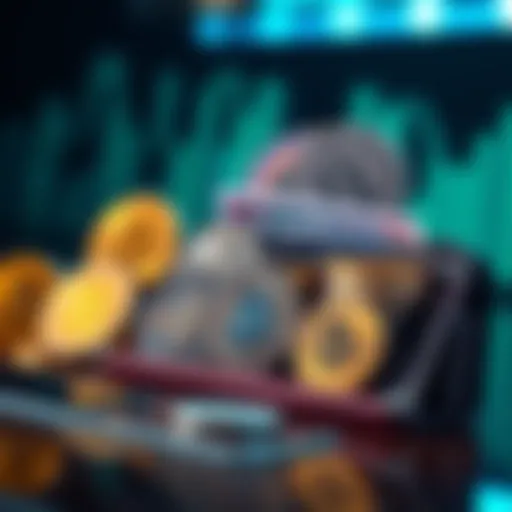Understanding NFT Smart Contracts: Functions and Impact


Intro
As the digital realm evolves, the concept of ownership is taking on entirely new forms. Enter NFTs, or non-fungible tokens, which have become a household name in the tech-savvy world. But what ties these digital treasures together? The answer lies in the smart contracts that govern them. These automated protocols not only empower creators to establish ownership but also lay down the foundational rules for trading and leveraging NFTs.
A smart contract serves as a self-executing agreement where the terms are directly written into lines of code. With the advent of blockchain technology, these contracts ensure transparency and security. Unlike traditional contracts, smart contracts don't require intermediaries, reducing costs and enhancing efficiency. The significance of this functionality has surged, especially in the landscape of digital assets, where clarity and trust are paramount.
In light of recent market changes and the surge in demand for digital collectibles, having a comprehensive understanding of NFT smart contracts is essential for investors, traders, and analysts alike. This article delves into the key features, benefits, and implications of NFT smart contracts. We'll explore current market trends, investment strategies, and future developments, providing you with the necessary insights to navigate this increasingly complex digital marketplace.
The Concept of Smart Contracts
Smart contracts are essentially self-executing contracts with the terms of the agreement directly written into code. They reside on a blockchain, ensuring that transactions are transparent and immutable. Understanding smart contracts is pivotal for grasping how non-fungible tokens (NFTs) operate in the digital landscape today. This understanding bridges the gap between traditional agreements and the innovative features offered by blockchain technology.
In the context of NFTs, smart contracts facilitate the creation, transfer, and management of these unique tokens. They eliminate the need for intermediaries, reducing transaction costs and enhancing efficiency.
Key Points About Smart Contracts:
- Automation: Once conditions are defined, smart contracts automatically enforce them, minimizing the need for manual intervention.
- Transparency: All parties involved can verify the terms and execution without any party altering the agreement post-creation.
- Security: With cryptographic protection, smart contracts help combat fraud and manipulation.
Defining Smart Contracts
Smart contracts were first conceptualized by computer scientist Nick Szabo in the 1990s. He proposed that a contract can be translated into code, which, if maintained in a secure system, can execute itself based on predefined rules. In essence, these contracts are not just agreements but programmable contracts that are carried out automatically.
The uniqueness stems from combining the traditional principles of contracts with more sophisticated digital processes. They are not merely about the execution of actions but also about providing evidence of obligations and rights.
How Smart Contracts Function
Smart contracts function based on a predetermined set of rules coded in the blockchain. Once the code is activated, it continually monitors the conditions and data in real time. This ensures consistent enforcement of contract terms without biases or human errors.
Autonomy in Transactions
Autonomy in transactions is perhaps the most significant characteristic of smart contracts. In a typical setting, various entities often need to validate transactions. Smart contracts, however, operate independently. The autonomy here means that once deployed, they require no intermediary involvement, as they can process and settle transactions themselves. This attribute offers notable advantages:
- Efficiency: Direct execution reduces time delays commonly associated with manual processes.
- Cost-Effectiveness: Eliminating intermediaries also slashes fees that would otherwise drain resources.
However, autonomy can pose risks too; for example, any unnoticed coding errors can lead to unintended outcomes since manual intervention is absent.
Conditions and Execution
The crux of how smart contracts function lies in their ability to set and enforce conditions. Specifically, conditions dictate the execution of actions, based on the scenario being monitored. For instance, in the context of NFTs, a condition might specify that the transfer of an NFT only occurs once payment is confirmed.
This dynamic can be beneficial as it:
- Reduces Disputes: Clear, codified conditions diminish the chances of misunderstandings between parties.
- Triggers Automatic Actions: Immediate execution means collectibles can change hands instantly upon meeting the agreed criteria.
On the flip side, if rigid conditions are established, unexpected situations might arise where the contracts can become cumbersome or inefficient, especially as new needs develop or if the original context changes.
Prolusion to NFTs
The world of digital assets has been transformed by the advent of non-fungible tokens (NFTs). At a glance, they offer a fresh perspective on ownership and value in the digital realm. In the context of this article, understanding NFTs is not merely an exploration of a trend but rather a deep dive into a technology that is reshaping how we perceive art, collectibles, and even ownership itself.
The importance of NFTs lies in their ability to provide a unique digital fingerprint for virtually any item, whether it’s a piece of digital artwork, music, or even tweets. By using blockchain technology, NFTs establish what it truly means to be the owner of a digital object, creating scarcity and enabling the kind of market dynamics that have long been prevalent in traditional art worlds.
Through this section, we will navigate the core aspects of non-fungible tokens. By understanding what they are and the unique characteristics that define them, investors and analysts can better assess their potential in various markets.
What Are Non-Fungible Tokens?


Non-fungible tokens are essentially digital certificates of authenticity that signify ownership of a unique asset. Unlike cryptocurrencies such as Bitcoin or Ethereum, where each unit is interchangeable and identical, NFTs are distinct and cannot be traded on a one-to-one basis. Each NFT represents a specific item or piece of content, often linked to digital art or music, where its value is heavily tied to originality and rarity.
This uniqueness is registered on a blockchain, which serves as a decentralized ledger. When we say that something is unique or non-fungible, we mean that it cannot be replaced or exchanged on a like-for-like basis. For example, think of a famous painting by Van Gogh; it has a specific value based on its originality and the artist's reputation, making it non-fungible.
Key Characteristics of NFTs
Uniqueness and Scarcity
One of the standout features of NFTs is their uniqueness. Each token has specific attributes or metadata that distinguish it from others. This characteristic of uniqueness extends to the concept of scarcity. In the world of digital assets, scarcity can be artificially created through limited runs or one-of-a-kind items. This notion adds to the allure of investing in NFTs because collectors often chase after items that are rare or confined in quantity.
Having scarcity inherently boosts perceived value; the more limited something is, the more people want it. This phenomenon isn't just about digital art; it can spill into gaming, where limited edition in-game items can fetch high prices. In this regard, blockchain plays a crucial role as it verifies the limited nature of the item through its ledger.
Ownership Verification
Ownership verification is another fundamental element of NFTs. The blockchain secures every transaction, allowing buyers to have the guarantee of authenticity and provenance. This transparency eliminates much of the doubt that can surround the ownership of digital or physical assets.
When you purchase an NFT, the transaction is recorded on the blockchain, meaning there’s a clear history of who owned it and any changes in ownership that have occurred over time. The direct link between a digital token and its owner provides a security layer not typically found in traditional ownership systems. This feature is especially beneficial for artists and creators, as it ensures that their rights can be upheld and that they can receive attribution for their work, regardless of how many times the token changes hands during resale.
The Intersection of NFTs and Smart Contracts
The fusion of NFTs and smart contracts marks a pivotal moment in the evolution of digital assets. This intersection is not merely a technical convergence but a transformative paradigm shift that fundamentally alters how we view ownership and provenance in an increasingly digital world. Smart contracts facilitate the creation, management, and overall functionality of non-fungible tokens, providing both creators and collectors with robust tools for interaction and innovation.
Role of Smart Contracts in NFTs
Creation and Minting Processes
The creation and minting processes of NFTs are heavily reliant on smart contracts, serving as the backbone of the entire ecosystem. During the minting phase, an NFT is transformed from a digital file into a token on the blockchain. This process is significant because it establishes the uniqueness of each NFT, ensuring that it cannot be duplicated. Each minting is executed through predefined conditions set within the smart contract, shaping how the token behaves and what rights ownership entails.
This mechanism not only reduces the chances of fraudulent duplication but also offers artists and content creators a solid assurance that their intellectual property remains intact. An advantage here is the automatic generation of metadata during minting, embedding essential details like the creator’s name and a link back to the original work. However, a disadvantage is that once an NFT is minted, its core attributes cannot be easily altered, meaning any errors in the metadata are essentially carved in stone.
Transaction Management
When it comes to transaction management, smart contracts further streamline the buying, selling, and trading of NFTs. They function by executing transactions automatically once set conditions are met. For instance, if a buyer places a bid that meets the seller’s specified price, the smart contract triggers the transfer of ownership seamlessly and efficiently. This characteristic enhances trust between parties involved and reduces the need for intermediaries, making transactions faster and often less costly.
However, this automated nature can also create challenges. If a smart contract contains bugs—errors in its code—there could be unintended consequences during transactions, potentially leading to loss of funds or assets. Therefore, while smart contracts significantly benefit transaction management by offering efficiency and reducing human error, they also require ongoing diligence to maintain their security and functionality.
Standards for NFT Smart Contracts
ERC-721 vs ERC-1155
When discussing the standards that govern NFT smart contracts, two acronyms often come up: ERC-721 and ERC-1155. The ERC-721 standard was the first to gain traction, specifically designed to create unique digital assets, making it extremely popular for traditional NFTs. Each token minted under this standard exists singularly, ensuring that each has its own individual value. This is beneficial for artists aiming to sell exclusive pieces.
On the flip side, ERC-1155 introduces a more versatile approach. This standard allows for the creation of both fungible and non-fungible tokens within a single contract. It drastically reduces the gas fees associated with transactions since a single smart contract can handle numerous token types efficiently. However, the complexity it introduces could be daunting for creators who are not tech-savvy, potentially alienating those who prefer straightforward implementations like ERC-721.
Implications of Different Standards
The implications of these different standards extend beyond mere functionality—they can influence how NFTs are perceived in the market and the community. The ERC-721 standard, while well-established, can see limitations in scalability, making it less desirable for creators who envision expanding their digital portfolios rapidly. ERC-1155, with its dual capability, opens doors to innovative use cases such as creating game assets or collectibles in a more streamlined fashion.
Each standard, though it has its strengths and weaknesses, contributes toward a broader understanding of NFTs and smart contracts. By recognizing their implications, investors and creators can make informed decisions that align with their specific needs and ambitions. Ultimately, navigating this landscape requires a deep understanding of how these standards work and their potential impact on the burgeoning world of digital assets.
"Smart contracts are the architects of the NFT ecosystem, crafting unique opportunities for ownership, creativity, and value."
In summary, the intersection between NFTs and smart contracts is not just about technology; it’s about reshaping the very fabric of digital ownership and interaction. From the minting of unique tokens to the management of transactions and diverse standards, this realm offers both exciting opportunities and challenges that require significant attention and understanding.
Benefits of Integrating Smart Contracts with NFTs
Integrating smart contracts with non-fungible tokens (NFTs) is a revolutionary approach in the digital asset landscape. This fusion offers a slew of benefits that not only bolster security and reliability but also enhance the economic potential of NFT transactions. When we speak of smart contracts in relation to NFTs, we're touching on something that serves as a backbone—enabling automation, trust, and transparency.


Enhanced Security and Trust
One of the standout benefits of utilizing smart contracts with NFTs is the enhanced security and trust they bring to both creators and collectors. Smart contracts operate on a decentralized blockchain, which means that once they're deployed, they can't be tampered with easily. This immutability contributes to a layer of assurance that can make a world of difference in a market that's often questioned for transparency.
More specifically, trust is built because buyers know that the smart contract will execute exactly as programmed; there is no middleman involved who can change the terms after the fact. This results in a significant reduction in fraud, as ownership is cryptographically verified on the blockchain. Secure ownership records protect both the buyer and seller, ensuring that both parties are getting what they bargained for.
Royalty and Revenue Generation
Royalty setups serve as another appealing feature of using smart contracts with NFTs. They have transformed how artists and creators can earn from their work through automated payments and resale royalties.
Automated Payments
The automated payments function of smart contracts represents a significant step forward in how financial transactions can be executed in the NFT space. Upon the completion of a sale, the smart contract instantly triggers payment to the seller, eliminating delays that are often seen in traditional payment systems. The key characteristic here is speed; the payments are not only swift but also executed without the need for manual intervention. This attribute makes these smart contracts an appealing choice for both creators and investors.
Moreover, the unique feature of automated payments is their programmability. Creators can set specific conditions for payments, such as defining milestones for art delivery or adjusting payment based on the sale price of the NFT. This provides a flexible and adaptive revenue model that can cater to various business strategies and objectives.
Resale Royalties
Resale royalties further amplify the financial benefit of incorporating smart contracts into NFTs. This aspect ensures that creators receive a percentage each time their work is resold, something that is rarely guaranteed in traditional art markets. The distinctive characteristic of resale royalties is their permanency—once programmed, they remain active for the lifespan of the NFT, guaranteeing ongoing revenue for artists.
Additionally, the unique feature of resale royalties lies in their potential to disrupt conventional payment structures. In a landscape where creators often have little control over secondary sales of their work, the ability to earn from future transactions can significantly impact their income and professional sustainability. However, the effectiveness of these royalties can be dependent on the marketplace implementing them correctly, making it a two-edged sword.
In wrapping up this section, incorporating smart contracts with NFTs reshapes how digital assets are created, sold, and tracked, establishing a more equitable ecosystem for all participants. This integration truly allows creators to flourish while providing collectors with an unprecedented level of confidence and security.
Challenges and Limitations
When navigating through the maze of NFT smart contracts, it's essential to address the challenges and limitations that come along with this rapidly evolving technology. The landscape is exhilarating, but it’s not without its pitfalls. This section elucidates key elements like security vulnerabilities and legal issues which can influence the adoption and performance of NFTs.
Security Vulnerabilities
Smart Contract Bugs
Smart contract bugs are akin to landmines; they can cause devastating effects if not handled properly. These bugs represent flaws in the code that can lead to unintended behavior, often resulting in financial losses, whether it be through contract failures or malicious exploits. One key characteristic of these bugs is that they stem from a lack of thorough testing. In the realm of finance, every line of code matters, as even the smallest oversight can create a critical security breach. In this article, recognizing these vulnerabilities is crucial, as they serve to remind us of the importance of meticulous code audits and developer expertise.
Unique bugs often surface, like reentrancy attacks—where a malicious actor repeatedly calls a contract before its initial execution is complete. This type of vulnerability highlights why developers must adopt robust coding practices along with comprehensive testing methodologies. While its risk is significant, addressing smart contract bugs can lead to stronger, safer systems overall.
Exploit Risks
Turning to exploit risks, this aspect reveals the darker side of the NFT landscape. Just as a strong house can be vulnerable to a determined burglar, smart contracts can fall prey to various attacks. This characteristic makes the security of these contracts an urgent area of concern. With NFT values skyrocketing, the potential rewards motivate hackers to exploit vulnerabilities. The consequences can be severe, including major monetary losses for creators and collectors alike.
These unique exploitations highlight the necessity of adopting security protocols and practices—like multi-signature wallets or limited access permissions to sensitive functions. On the downside, the rising threat of exploit risks can deter potential investors who may favor established methods over newer tech. In summation, while awareness of exploit risks underlines the importance of security in smart contracts, they can also create hesitancy amongst those looking to enter the NFT market.
Legal and Regulatory Issues
Intellectual Property Rights
Moving into legal complexities, intellectual property rights represent a critical aspect for creators in the NFT realm. Artists and developers finding their work protected legally may prove arduous. This area is contentious because, while blockchain technology enables easy transfer of ownership, it does not inherently protect the original creator's rights. A key characteristic of intellectual property rights in this context is the ambiguous distinction between ownership of the token versus ownership of the underlying artwork itself. This uncertainty is a double-edged sword; on one hand, it provides opportunities for creators to tokenize their work, but on the other, it raises significant questions regarding rights and protections.
The unique feature surrounding intellectual property rights is the necessity for creators to ensure their work is properly represented and protected. Additionally, as laws evolve, staying compliant creates a secondary layer of complexity—especially for those operating in multiple jurisdictions. The risks tied to intellectual property can create hurdles for those keen on the NFT market.
Compliance with Laws
Last but not least, compliance with laws can be a labyrinthine endeavor in the world of NFTs. Jurisdictions vary considerably regarding digital assets, which often leads to confusion among creators and traders alike. Companies must align with local and international regulations, which can differ dramatically based on geographic considerations. A key characteristic of compliance is its ever-changing nature. Regulations concerning digital currencies and assets can shift overnight, making it essential for stakeholders to keep a vigilant eye on legal developments.
The distinctive feature of compliance challenges lies in the potential for significant financial penalties or legal ramifications if one operates outside legal boundaries. For many, the uncertainty surrounding regulatory issues can act as a deterrent, hindering the growth of the NFT sector. Additionally, compliance can result in overhead costs that not all startups can afford, potentially stifling innovation. Overall, navigating compliance is a delicate dance; it holds the potential for success but also poses considerable risk.
As NFT smart contracts continue to evolve, understanding their challenges and limitations will empower creators, investors, and innovators to make informed decisions, avoiding pitfalls along the way.


Future Trends in NFT Smart Contracts
The landscape of NFT smart contracts is ever-changing, and keeping an eye on future trends is vital for anyone interested in this space. As technology and the market evolve, new trends are emerging, promising to reshape how these contracts are utilized and perceived. Understanding these trends not only helps in making informed decisions but also allows creators and investors to harness the full potential of NFTs. It’s like keeping your ear to the ground; those who are attentive stand to gain the most.
Technological Innovations
Interoperability Solutions
Interoperability refers to the capacity of various systems to work together seamlessly. In the world of NFT smart contracts, interoperability solutions enable different blockchain platforms to communicate and exchange information. This allows NFTs from one protocol to be used on another, increasing their utility and reach. Imagine owning a digital art piece that's not confined to a single marketplace but can be showcased across multiple platforms; that’s the power of interoperability.
Key characteristic: Its primary draw lies in fostering a decentralized ecosystem where users can engage with NFTs in diverse environments.
Unique feature: Such solutions often involve bridging technologies that create a connection between blockchains, making the process more efficient. For example, platforms like Polkadot and Cosmos focus on enabling different chains to interoperate.
Advantages and disadvantages: One significant advantage is the enhanced liquidity, as NFTs gain access to wider audiences. However, challenges arise regarding transaction speed and the complexity of the underlying code which can lead to bugs if not properly managed.
Cross-Chain Functionality
Cross-chain functionality is another critical element within NFT smart contracts. It allows assets and data to be transferred between different blockchain networks without losing their value or integrity. This opens up many doors for users wanting to leverage the strengths of various blockchains.
Key characteristic: It facilitates a more integrated and cohesive network among various blockchain technologies.
Unique feature: A notable example is Ethereum’s integration with Binance Smart Chain through wrapped tokens, which let users move their assets freely between the platforms, bridging the gap between disparate ecosystems.
Advantages and disadvantages: The advantages of cross-chain capabilities lie in reduced transaction costs and improved scalability. On the downside, these systems can be complex, and misconfigurations can lead to vulnerabilities, making thorough testing essential.
Market Potential Expansion
New Use Cases in Art and Gaming
As NFTs gain traction, new use cases are cropping up, especially in art and gaming sectors. Artists are leveraging smart contracts to assert ownership, authenticate their crafts, and receive royalties from secondary sales. This sparks a transformation in the traditional art scene, where issues of forgery and loss of profits due to resale are prevalent.
Key characteristic: The ability to create limited editions and verifiably unique pieces has become invaluable.
Unique feature: For example, the integration of NFTs in gaming allows players to own in-game assets that can be traded or sold externally, essentially creating a real-world economy. Games like Axie Infinity are leading the way here, allowing players to earn real money through gameplay.
Advantages and disadvantages: The significant advantage is that artists gain more control and revenue from their work. However, this paradigm shift may alienate traditional collectors who are not tech-savvy or willing to adapt to these new systems.
Emergence of Decentralized Finance (DeFi)
Decentralized finance is making waves, and its synergy with NFTs adds a new dimension to the market. Combining DeFi with NFTs allows for more fluid asset management, lending, and even borrowing against NFTs as collateral.
Key characteristic: This intersection is creating liquidity pools specific to collectible and unique assets.
Unique feature: Platforms like NFTfi have showcased this relationship by allowing NFT owners to put up their tokens as collateral for loans. This is groundbreaking; it enables holders to leverage their assets without sacrificing ownership.
Advantages and disadvantages: The primary advantage here is that it opens access to funds for those who may not liquidate their assets. However, it also introduces risks related to valuation aesthetics, where the worth of art or collectibles can be subjective, landing users in tricky situations if asset valuations decline.
The future of NFT smart contracts hinges on adaptability, creativity, and seamless integration of emerging technologies. Those who stay ahead of the curve will likely ride the waves of innovation successfully.
The End
The exploration of NFT smart contracts within this article highlights the transformative nature they possess in the digital landscape. As we draw to an end, it becomes clear that smart contracts are not simply a passing trend but rather an essential building block for decentralized applications, especially in the realm of non-fungible tokens. The significance of NFT smart contracts lies in their ability to ensure autonomy, security, and efficient management of digital assets. They eliminate the need for intermediaries, which can lead to faster transactions and lower costs while reducing potential for fraud.
Summarizing the Importance of NFT Smart Contracts
NFT smart contracts serve a crucial role in the creation and functionality of non-fungible tokens. Their ability to establish verifiable ownership and the terms of exchange adds undeniable value to the digital marketplace. By automating various processes — from the issuance of royalties to the validation of ownership — these contracts provide a level of transparency that was once absent in traditional art and collectibles markets. So, when creators and collectors embark on their journey into the NFT space, understanding the functionalities of smart contracts can no longer be optional but rather a necessity.
"In the fast-evolving world of digital assets, knowledge becomes the new currency."
Encouraging Further Exploration
While we’ve scratched the surface regarding NFT smart contracts, there is still much to uncover. The integration of smart contracts into mainstream applications heralds a new era, but navigating this developing territory demands continuous learning and adaptation. Future trends promise innovations such as greater interoperability between different blockchains and novel use cases extending beyond art into realms like gaming and virtual real estate. Investing time in understanding these aspects could illuminate new opportunities for traders, analysts, and advisors. For those eager to delve deeper, reliable resources such as the Encyclopedia Britannica and dedicated forums like Reddit offer platforms for discussions and insights on the ever-evolving NFT landscape. As this field continues to grow, being informed on the latest developments will provide a competitive edge.















